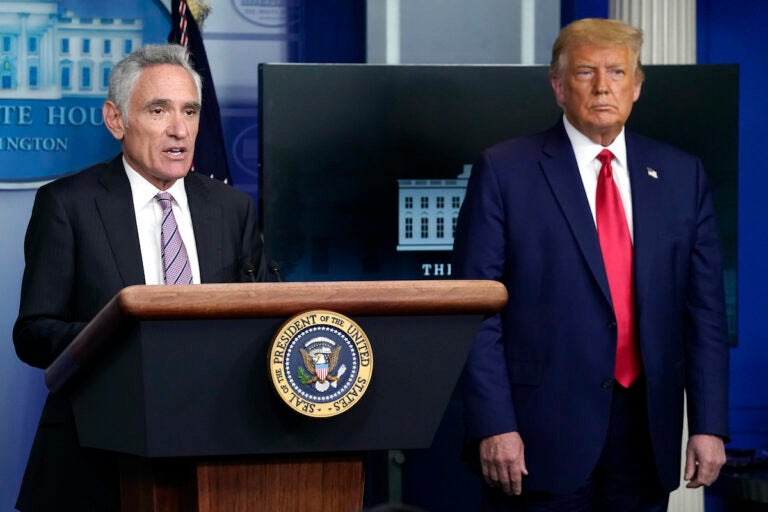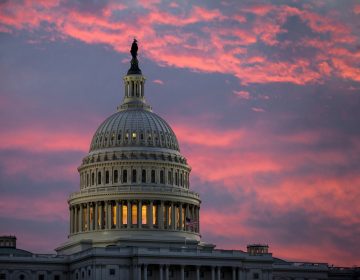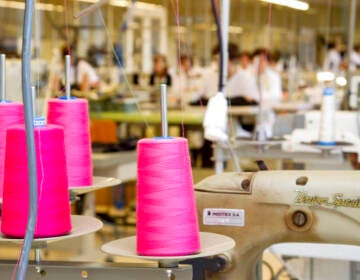Covid task force in disarray and winter social distancing
We discuss how the U.S. pandemic response get derailed and ways to stay safe and sane this winter as Covid rates rise.
Listen 49:45
White House coronavirus adviser Dr. Scott Atlas speaks as President Donald Trump listens during a news conference at the White House, Wednesday, Sept. 16, 2020, in Washington. (AP Photo/Evan Vucci)
As Covid numbers soar across the country and deaths reach 220,000, President Trump has continued to downplay the pandemic, even holding rallies in virus hotspots. A recent investigation by the Washington Post found that the White House has largely abandoned actively fighting the pandemic. We’ll talk with Washington Post health policy reporter YASMEEN ABUTALEB about the Trump administration’s coronavirus response and how Trump advisor Scott Atlas has repeatedly derailed public health efforts. Then, as the temperature dips and infection rates rise, many people are wondering how they will survive the winter cooped up indoors. We talk with University of Pennsylvania social epidemiologist CAROLYN CANNUSCIO about how to prepare for the challenging months ahead, the importance of contact tracing, and how to change people’s minds around masks and vaccines.
Interview highlights
On exhaustion:
Marty Moss-Coane: I have to say, I myself and I think everyone that I talked to has said the same thing, which is we just feel burned out trying to deal with this crisis and deal with it. I would say at this point, rather unsuccessfully. Do you share some of that concern and frustration?
Carolyn Cannuscio: Absolutely, I think it’s very normal for all of us to be exhausted, weary, done with this thing. But it’s also true that we have to dig deep and find the resolve and the reserve to prepare for the next few months because the pandemic isn’t done with us.
M: Well, clearly, and that’s one of the reasons we wanted you on the show. But let me just sort of add to the frustration. I think, for people, and I would include myself, who have frankly taken steps to limit human contact, have canceled Thanksgiving plans, wear masks, socially distance, don’t go to bars. I mean, you’re doing the things that you and others have told us to do. We’re feeling a sense of frustration when we see that many other people are not doing that and we see these numbers going up, which they are.
C: Absolutely. We’re at a very difficult moment in the pandemic for all the reasons you’ve described. I want our listeners to focus on something, though, that I think is being lost. Because people are so tired right now in Pennsylvania, we’re averaging about a thousand new cases a day. That puts us back in the spring in terms of risk of community transmission. So think back to April and May, what we were doing. We were all locked down at home. It was clear what we were supposed to be doing. We were allowed to go out for work. We went out for exercise and groceries and medical care, and that was about it. So the guidelines were pretty clear. But still, we were seeing high case counts. Right now we have an emergency brewing, but I think people aren’t as aware of the high risk of community transmission. So what we see in our work as contact tracers is very interesting to me as a scientist and as a human being. We see that there are many people like you and like me who have decided on household policies that are pretty strict and not so different from the lockdown policies that were imposed upon us by our local and state authorities. Right now, we don’t have those outside policies set by our municipality or city, for example. So people are really interpreting differently what constitutes safe pandemic interaction. And while lots and lots of people are restricting their face-to-face social interactions, what we’re learning is that it really doesn’t take a lot of people or a lot of households interacting quite a bit to introduce risk to so many of us.
On testing:
M: Is testing overrated?
C: Oh, my goodness. I have strong feelings about this. So let’s use the example of the outbreak in the White House and the corridors of power. I think there was the mistaken impression that if there was just enough testing that any new case would be identified and outbreaks would be prevented. So the problem is our tests are not perfect and false negatives can truly happen. And it’s highly consequential in some circumstances to miss a person who is actually positive but tests negative. Someone who’s got an infection brewing could test negative today and they could test positive tomorrow. So testing can lull us into a false sense of security. And I have heard about people, including people I love very much, who are using testing as a way to engage with vulnerable family members. So actually, a family member called me last night and said one of our loved ones, a young person, went to a party. It turned out that several people at that party tested positive for COVID. Our loved one was notified by the health department, actually developed a fever, went to get a test. Tested negative. Used that information to then go visit other family members of ours. Later, she tested positive. So my message to all listeners is to layer on your prevention strategies. Never act like the test is absolutely perfect. It’s not your free pass to do whatever you want. That can put other people at risk. If you are exposed to someone with COVID, get yourself into quarantine for two weeks. That means stay away from other people.
On contact tracing:
M: Well, let’s talk a bit about contact tracing. And one of the job descriptions I ran into in preparation for the show, which is it’s part psychiatrist, part detective, part problem solver. And I thought, boy, those are really very sophisticated skills. What kind of skills do you think you need to have if you’re a contact tracer?
C: You need to have the ability to build a relationship very quickly with someone who might be skeptical about why they’re talking to you in the first place. So that’s why that job description includes the psychiatrist part, because it’s really about reading people and trying to understand what their fears and concerns are, trying to allay those fears and concerns and trying to engage them really as partner scientists and figuring out what’s going on with the pandemic. So I think it’s very important for contact tracers to be so compassionate and curious. You have to be pretty willing to ask difficult questions and pretty okay with hearing lots of different kinds of answers, because people are going to be telling you about personal aspects of their lives.
M: Are people willing to open up to a stranger, so to speak, about maybe some more intimate details of their personal life?
C: So there’s this prevailing narrative in the news about contact tracing that people aren’t willing to speak with contact tracers. And while there is variation, many people are very interested in stopping transmission and they really want to talk it through and figure out, How did I get infected? and How can I make sure I didn’t infect anyone else? It’s such a burden for people to carry when they have COVID. There’s a lot of anguish that we hear among people who are so worried that they may have exposed children in their care, for example, or they may have exposed their elderly loved ones. So I did some contact tracing calls yesterday and I had a call that lasted for two hours. And people really want to be partners in talking through: What are all the places I could have been exposed? and What are all the places where I could have exposed someone else?
On social pods:
M: Let’s talk a little bit about pods. And I know some people have created some pods. And obviously we’re looking ahead to cooler weather in the fall. And then, of course, you know, winter arrives and we’ve got several months of generally bitter cold weather when it is harder to be outside. First of all, what is a pod in terms of dealing with this pandemic and how do we create one?
C: The concept of a pod is a small social unit that combines two or more households for social interaction for an extended period of time. The concept of a pod really should be that members of that pod are with one another and excluding from social contact with all other people. There is a fidelity between and among the pod members. A general principle is that the smaller the pod is, the easier it’s going to be to manage and the lower the likelihood of exposures of any one of those pod members to COVID, in terms of the likelihood of introducing a risk within the pod. And I have some guidelines in mind for building them. First of all, it’s important to pick pod mates who have similar concepts of risk taking, risk tolerance and a similar number of weekly or daily exposures on average. It’s difficult to pod up with people who may be much more socially active and to think that you’re in any way managing your risk. The sort of highest risk member of your pod represents the risk to your whole pod. So assess the level of risk taking, the level of exposure through obligatory activities like work and school and try to match yourselves up that way. Second, this is a relationship that is going to be a very intimate relationship. It’s a relationship that requires a very high degree of trust and transparency and communication. This is not a casual fling. This is a very serious kind of relationship because you’re trusting one another with managing exposure to a potentially deadly virus. So it’s very serious. So assess risks, then figure out who you really trust. And I think it’s important to also really think about who you enjoy. This is about trying to weather this really difficult period and introduce some pleasure that will leaven the very dark days and bring some joy to the members of our households.
Transcript has been edited for length and clarity
WHYY is your source for fact-based, in-depth journalism and information. As a nonprofit organization, we rely on financial support from readers like you. Please give today.





